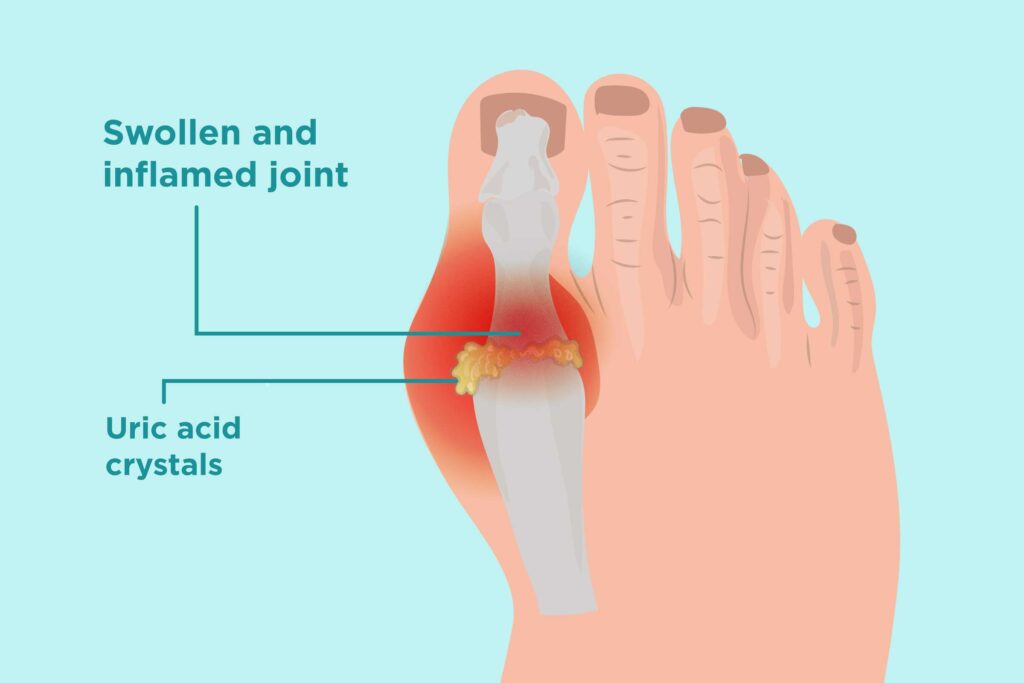Uric acid is a waste product that’s created when your body breaks down chemicals called purines in food and drinks. Sometimes, uric acid can build up in the joints and tissues, causing a range of health problems. Most uric acid dissolves in your blood, passes through your kidneys and leaves your body in your urine. Hyperuricemia happens if too much uric acid stays in your body. In this article, we list the typical low, normal, and high levels of uric acid for males and females.
Uric acid levels are typically 2.5–7.0 milligrams per decilitre (mg/dL) in males and 1.5–6.0 mg/dL in females. Low levels are rare, but high levels can lead to gout, kidney disease, and other health issues.

Having some uric acid in the blood is normal. However, if uric acid levels go above or below a healthy range, this can result in health problems. High uric acid levels can increase the risk of gout. It is unusual to have low uric acid levels in the blood, but low levels in urine can indicate certain health conditions where a person passes too much uric acid out of their body as waste.
How Uric acid can build up in body

Purines are chemical substances that occur naturally in the body and in some foods. When the body breaks down purines, this creates uric acid as a waste product. The kidneys filter it from the blood and pass it out of the body in the urine.
However, uric acid can sometimes build up in the blood. The medical term for this is hyperuricemia. It can occur if the body produces too much uric acid or does not get rid of enough of it.
Too much uric acid in the blood can lead to crystals forming in the joints and tissues, which may cause inflammation and gout symptoms.
Causes
The causes of high uric acid levels are not always clear. However, genetics and environmental factors, such as diet and healthy diet play important role.
Risk Factors for hyperuricemia include:
- Metabolic syndrome
- drinking alcohol
- being male
- high blood pressure
- diabetes
- a diet that is high in foods and drinks that contain or raise purines, such as red meats, some seafood, beer, and whiskey
- diuretics
- a diet high in fructose, present in sodas and most processed foods
- conditions that cause a rapid turnover of cells, such as blood cancers, psoriasis, and certain types of anaemia
- certain immunosuppressant medications
Symptoms
A person with high or low uric acid levels may not always have symptoms. Symptoms may not appear until a person has had levels outside the normal range for a long period, which can cause health problems.
Symptoms of gout, which high uric acid levels can cause, include:
- painful or swollen joints
- joints that feel warm to the touch
- shiny, discoloured skin around the joints
Symptoms of a kidney stone, which high uric acid levels can also cause, include:
- back pain
- pain in the side
- frequent urination
- urine that is cloudy, smells unusual, or contains blood
- nausea or vomiting
Low uric acid levels are less common than high ones. A person with low uric acid levels may urinate more than usual, which can cause dehydration if they are not drinking enough water.

Diagnosis
A uric acid test measures the amount of uric acid in the blood or urine.
A person may need the test if they have gout symptoms or kidney stones or are undergoing cancer treatment. The test does not carry any risks.
A healthcare professional may take a small sample of blood with a needle or ask the person to collect their urine over a 24-hour period. Laboratory technicians will then test the sample for uric acid levels.
Doctors may sometimes also perform a joint aspiration, in which they use a needle and syringe to remove a small amount of fluid from a swollen joint. The presence of uric acid crystals in the fluid indicates gout.
If the doctor needs more information to diagnose health problems that link to uric acid, they may do a physical examination and ask questions about the person’s medical history and current symptoms.
Sometimes, a person will have high uric acid levels but no symptoms of a medical condition. They are unlikely to need treatment unless they develop symptoms.
Treatment
Certain foods contain purines, which create uric acid when the body breaks them down. Eating a diet that is too rich in purines can cause uric acid to build up in the blood.
It is not possible to avoid purines completely because small amounts are present in many foods. However, a person can follow a low purine diet and take other steps to help lower purine levels.

People can take steps to prevent gout flares. These include:
- avoiding alcohol
- reaching or maintaining a moderate weight
- protecting the joints with gentle, low-impact exercise, such as walking, cycling, and swimming
A person who has gout usually needs a uric acid test every six months.
Keeping uric acid levels within a certain range can reduce pain, joint damage, and complications from gout.





Thanks for sharing. I read many of your blog posts, cool, your blog is very good. https://accounts.binance.com/lv/register?ref=B4EPR6J0
Thank you for your sharing. I am worried that I lack creative ideas. It is your article that makes me full of hope. Thank you. But, I have a question, can you help me?